Invalid expected finish dates in Primavera P6



Expected Finish dates in Primavera! How do they work? How should we be careful while using them? Let's find out!
The cut-off date of your project is a couple of days ahead, knocking at your door, calling for another progress update in Primavera P6. One of the many existing methodologies to give an update on your project schedule is using expected finish dates. It is a powerful option, but with great power comes great responsibility. In this blogpost we will learn briefly about expected finish dates and what can happen if we use expected finish dates incorrectly.
Learn MoreWhere to find expected finish dates?
The expected finish field can be found on the activity details window of the activities tab of Primavera P6 under the status subtab as can be seen in the screenshot below.
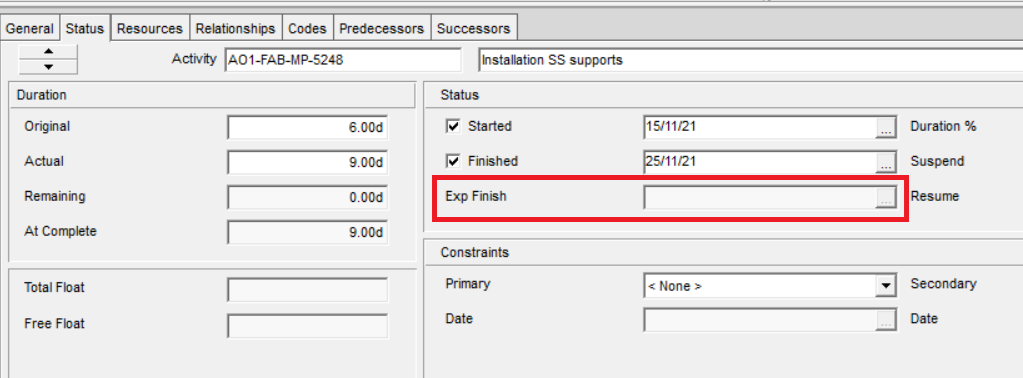
The expected finish field is only enabled for activities that have their activity status set to in progress or not started.
What do expected finish dates do?
An expected finish date comes into effect while scheduling your project. It updates the remaining duration of the activity to meet the expected finish date you set. It cannot create a negative remaining duration in an activity. Let us elaborate on it shortly with an example project. The graphic below can be considered as the high-level schedule of an example installation project. We will give monthly updates to this project which has a cut-off date at the end of December (red bar | ). By the way, if you do not know how to update your project planning, you should definitely check the blogpost of Marion Goeteyn on how to update your project planning in P6 with 7 easy steps.

The animation below shows how an in progress activity gets updated when the expected finish field is not filled. As can be noticed, if the planner does not do anything, Primavera uses the same remaining duration for each activity as before.

The animation below will help us to understand how setting an expected finish date impacts the remaining duration throughout the updating process. We are using a red arrow (V) to show the expected finish date we have used in Primavera P6 before rescheduling

As can be noticed from the 2nd animation, in December and January updates, the expected finish date was set by the planner at the end of February while in the February update the expected finish date was set by the planner to mid-March. Primavera uses the expected finish date to correct the remaining duration automatically so that the activity will finish on the desired expected finish date submitted by the planner. Smooth!
Invalid expected finish date examples
A project schedule is only considered complete when it reaches a high quality. The end user of the project schedule should;
- have easy access to correct insights
- find non-conflicting information
- be able to run scenarios with the existing information and logic
This end user can be another stakeholder or the planner himself. Submitting high quality schedules serves all parties! Let us look at a couple of examples where the expected finish date was used improperly or leads to confusion.
1 Expected finish dates used in “Not Started” activities
Using hard and soft constraints leaves an asterisk (*) on the date column as an indicator that the activity has constraints assigned. Expected finish dates on the other hand don’t work like this. They can only be seen by
- the planner when he opens the activity detail tab
- the reader, in case the expected finish column is shown in the activity table
Therefore, usage of expected finish dates should be limited to activities with “In Progress” status. Expected finish dates that have been assigned to not started activities in the past and that were neglected to be removed, can jeopardize future progress updates and scenario analyses. The animation below explains how we are losing our original duration due to usage of forgotten expected finish dates on not started activities.

Expected finish dates are often used by planners in the beginning to estimate the original duration. Even though it is not advised to estimate original durations via using expected finish dates, they should be removed before finalizing the project base schedule in case they have been used.
2 Expected finish dates before the data date
A complete project schedule should contain comprehensive and non-conflicting information. Expected finish dates that are set before the data date will be overruled by the data date and result in 0 days of remaining duration calculation due to the fact that remaining duration cannot be negative.

The example above gives an impression of not having any plan or of being forgotten to progress activity “Preparation”. A not completed activity should always be expected to be completed on or after the data date.
3 Expected finish dates before the data date in combination with remaining units
If the expected finish date of an activity is set before the data date, it usually means the remaining duration will be calculated as zero (as you can see above). However in the case where there are resource assignments on this activity, the remaining duration will NOT be zero and instead be calculated by the remaining units.
The image below is retrieved from a planning which has a cut-off date on 01/06/2022 and the activity still has remaining units.
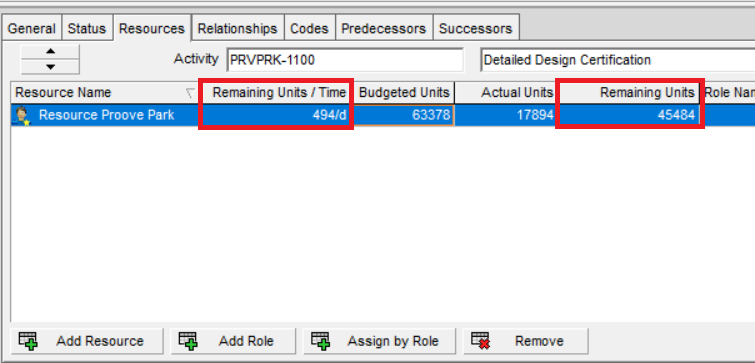
Primavera P6 neglects the expected finish date assigned before the data date (30/04/2022) and calculates the remaining duration by dividing 45484 by 494 (92 days) to calculate the finish date.
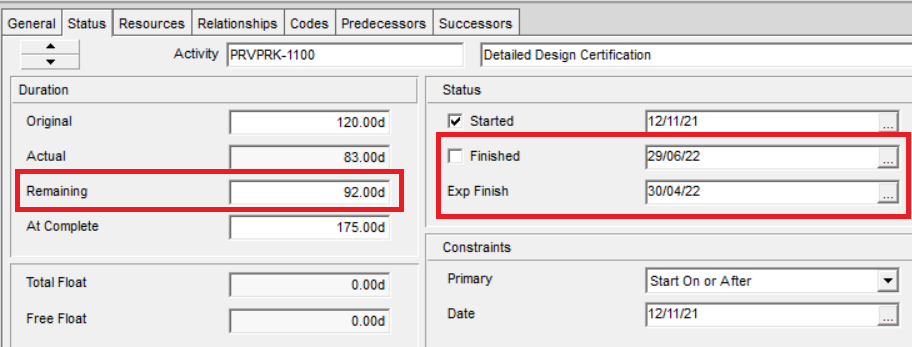
These kinds of discrepancies are considered as conflicting information.
4 Expected finish dates used in combination with constraints
Expected finish date will overrule constraints used in the schedule. As it can be seen below, Primavera P6 calculates the finish date by using the expected finish date and overrules the primary constraint date.
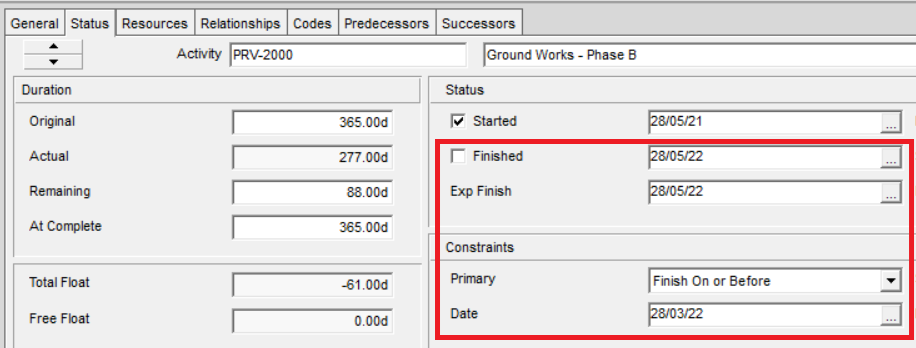
This is another example of providing conflicted information in one activity. A primary constraint will always be overruled even if the constraint is a hard constraint.
The only exception for a primary constraint to overrule the expected finish date is when:
- The activity status is not started,
- the expected finish date is before the primary constraint date and
- the primary constraint type is impacting the start date of the activity such as:
- Start on or after
- Start on
- Mandatory start
5 Expected finish dates used in combination with calendars
If your activity’s expected finish date is on a date the activity cannot work because of calendars, it will take the earliest possible date before the set expected finish date.
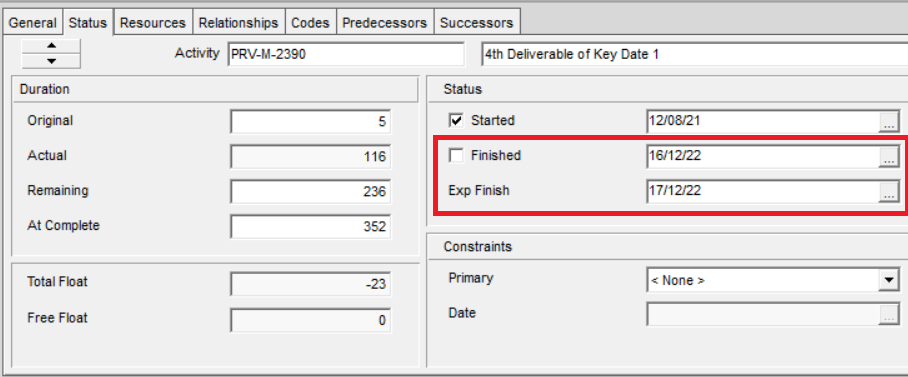
For instance, in above example it can be noticed that activity has an expected finish date assigned on a Saturday. On the other hand this activity has a 5-days-workweek calendar assigned. Therefore Primavera automatically takes earliest possible date before the set expected finish date, which is a Friday.
Conclusion
The expected finish date is a helpful tool to speed up and organize our project planning updates. Knowledge of what can happen if the expected finish date is being used incorrectly will give us power to avoid providing conflicted information and help us to finalize comprehensive project schedules.


